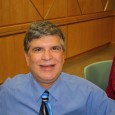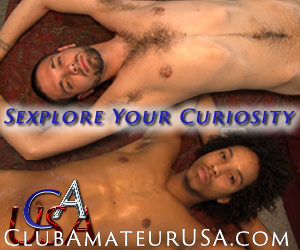According to Liz Highleyman (“Past Out”), gay “motorcycle clubs, a mainstay of gay culture since the 1950s, ushered in a new brand of queer masculinity and gave rise to today’s leather/SM community.” After World War Two, many gay men who returned to civilian life after military service stayed in gay-friendly port cities rather than go back to their home towns. Many of them, wrote Guy Baldwin, “sought to retain the easy camaraderie, the stress and thrill of real risk taking, and the masculine sexuality that they had known during their military days.” Inspired by the outlaw biker image made popular by Marlon Brando in The Wild One (1953), gay men founded the first gay motorcycle club, the Satyrs, in Los Angeles (1954). By the mid sixties San Francisco’s South of Market district had become a “hotbed” of the gay bike club scene, as clubs spread throughout California and across the USA. “Gay motorcycle clubs provided an outlet for socialization – and often for sex,” Highleyman wrote. “The early biker scene was closely allied with the emerging ‘Old Guard’ leather/SM culture, and the clubs’ watering holes became some of the first leather bars. Stylized biker gear became a sort of uniform for a segment of the gay community, featuring engineer boots, crotchless black leather chaps, and military-style caps.”
In South Florida, the Thebans Motorcycle Club, Inc. of Miami was founded as a domestic, non-profit corporation on August 6, 1975. By 1976 the Thebans were visible enough to be one of the co-founders of the Dade County Coalition for Human Rights. By the 1990s, gay bike and leather clubs like the South Florida Eagles, Sunrays MC, the Brotherhood of Man MC, Stingrays, Saber MC, Key West Wreckers and the South Florida chapter of Trident International were a major part of the local leather scene. These “patch” clubs, named after the patch or colors that members wore on their leather vests, were patterned after outlaw motorcycle clubs (MC’s) like Hell’s Angels. Thus, they incorporated most of the exclusive rules, hierarchies, pledge periods, point systems and secret handshakes of the outlaw clubs. Above all, the clubs satisfied a need: “Gay men’s need to bond in groups is one of the least recognized aspects of our culture,” wrote John Preston in Leatherfolk (1991). “A leather club gives one an immediate sense of fraternity in the most common and acceptable form. You are nominated for membership; someone likes you. You are voted into membership; you have a circle of friends. You are often elected to a leadership position (such clubs have untold numbers of offices to fill); your friends think you are a competent person.”
I was an active member of Saber MC from 1985 until the club declined around 2005. I served the club in various offices, including that of President. For this article, I interviewed some of the surviving club members, including the Rev. Anthony Borka (Saber), Joe Millman (Trident), Richard Sedlak (Saber) and a founding member of Trident who asked to remain anonymous. During their heyday, clubs were active in both the leather scene and the “mainstream” LGBT community. They hosted parties, bar nights, leather runs (weekend outings), and fundraisers for gay and AIDS groups.
According to Sedlak, “from the 70s to well into the 90s the South Florida leather scene was much different than it is today. For one thing there were about 7 or so clubs, most of them being motorcycle clubs, plus several fetish groups. There was considerable interaction between the clubs and plenty of willing venues to hold fundraisers and other events. As a side note, while recently talking with Jim Rakvica, who was the owner of the very popular Tacky’s Bar, we both agreed that the type of bar Tacky’s was would not be able to exist in this day and age. I have heard it said among us ‘old-timers’ that it is not as much fun being gay as it used to be. Millman, who co-founded Tridents, recalls meeting “some wonderful people that were members of the leather scene,” including his partner, Rev. Borka. “It was a very warm and close-knit family.” Clubs like Saber MC were true brotherhoods for those who us who were members. I do not have any blood brothers of my own so the Sabers were the brothers that I never had.
By the time Trident International South Florida began in 1997, AIDS has taken the life of many of the older clubs’ members. According to its founder, “by the time the 90s had started, drugs, and specifically crystal meth, had already been a specific element to the culture of sex parties, particularly among the FFA [a fetish club devoted to fisting]. People were dying with regularity. I would get to know someone one year, have a good time with them, and they would be gone the next. I think we lost a lot of word-of-mouth history with many deaths. I remember hearing about ‘Old Guard’ leather customs that were passed from Master or Daddy to Slave or Boy. In the 90s leather more often than not passed from the dead to the living, by whoever could use it. “
”By the time we formed Trident, people had started to survive. For a while we had quite a following, and were very involved with other clubs that were around in those days. Trident was a founding member of the Southeast Conference of Clubs, and its spokesperson was the founding treasurer, who also designed the logo. Trident members could be found at events all throughout the Southeast. Between Trident, Saber and the Key West Wreckers, South Florida was fairly well represented in events all throughout the Southeast, and people traveled from Georgia, Louisiana, Virginia, North and South Carolina and other parts of Florida to attend our events. Drugs, and particularly meth was becoming more common among the leather community, however, and was spreading outside the community among the LGBT community “
From the 70s to the 90s, proud gay leathermen like Gregg Adams, Brad Buchman, Jim Fluker, Eric Lawrence, Mitch Novack, Harvey Pearson, Marty Rubin, Richard Sedlak. Steve Selwyn and Ed Wolfe were active in gay community organizations, not just leather ones. Gay leathermen founded Center One, Broward’s oldest AIDS service group, and HEALTHLINK, which helped financially-strapped people living with AIDS. Except for Sedlak, none of those men are alive today. Borka remembers Fluker, who was also Sedlak’s partner, as one who was “very involved with the Sabers, did a lot, and died from AIDS at a young age.” According to Sedlak, “the most important club brother I would make note of is Steve Selwyn, the principal founder [with Sedlak] of Saber MC, who was a very popular and well-respected true leatherman. After his passing the club annually issued the Steve Selwyn award to those who gave service not only to the leather community but to the overall LGBT community as well.”
After the turn of the millennium, a new generation of gay leathermen came of age who did not feel the need to join leather or bike clubs. To these young leathermen, the clubs’ rules and regulations were too restrictive; their membership too ancient; and their purpose too outdated. Besides, they argued, why go through a rigorous pledge period and boring meetings when there existed a wide variety of sex clubs, fetish clubs and nudist clubs that only required them to pay a membership and admission fee to have a good time? Borka agrees: “Leather clubs were no longer needed as people were welcome in leather clubs of whomever. There was no longer the isolation. Gay motorcycle clubs flourished and younger guys were not interested in joining old hairy men groups.” Sedlak, on the other hand, is more optimistic: “All those groups are now gone, but there is hope with new clubs like the Minotaurs and other leather/SM fetish groups. I have personally met them and found their club to be very dedicated to carrying on the legacy.”
The Tridents founder attributes the clubs’ decline to “drugs and politicking. People did not want to go to events only to be sneered at or have rumors flying around about what he said or he said. And the meth epidemic took a lot of people out of circulation as well, devastating groups of people. And those of us that got clean did not want to be out and about and around those that were using. And the Internet helped the decline. The leather community was at one time the gatekeeper for all things kink, and with the advent of AOL chat channels and then all the other sites that eventually emerged, it became much easier to find people into kink without having to buy expensive hand-crafted clothing. Leather became something separate and distinct from kink, and the leather community became about appearance and for some, a way of life, rather than what went along naturally with all the various forms of kink. People who had no connection to the leather community were throwing fetish parties, and subsequently the kink that was entirely associated with leather now had no connection with leather at all.”
“Is there still a leather community?” Borka asks, rhetorically. “It was a lifestyle. Now it is a matter of dressing up as if wearing an armband makes one a leatherman. Being a leatherman meant being comfortable in your own skin, enjoying dressing in leather, participating in kinky sex. Now, as I said, the leather scene is just dressing up in leather, but not a lifestyle.” Like the Tridents founder, Sedlak blames the Internet for the decline of the leather and bike clubs. “Everyone finds it easier to simply go online to look for what they want, find a trick on Grindr, and then do texting! Whatever was wrong with actually talking to someone in person, to really get to know them and make a meaningful connection. It was the aforementioned Jim Rakvica who noted that four young lesbians sat at a table in one of our local restaurants and promptly started texting. No one spoke to anyone else – and one of them was actually texting her friend who was sitting right across from her! How sad that we seem to be losing the art of really communicating by using the most personal form we have, simply, talking.”
Jesse’s Journal
by Jesse Monteagudo








